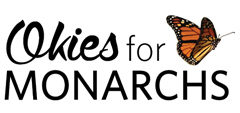 MATT FULLERTON
MATT FULLERTON
Wildlife Biologist – Threatened & Endangered Species, Oklahoma Department of Wildlife Conservation
As a biologist whose focus is on Oklahoma’s rare and declining species, I am often asked “What can I do to help ‘Species A’?” Mind you, “Species A” in the conversation may be anything from an endangered bat to a freshwater mussel.
As you might expect, there is typically no easy answer. One factor that can be attributed to nearly all declining species is habitat loss resulting from anthropogenic (manmade) activities. Different species face various hurdles in the race towards population recovery.
In recent decades, scientific research has made it glaringly obvious that pollinator species across the board have been experiencing declines. Initially, the “buzz” was on European honey bees, but that was merely the catalyst for pollinator insects as a whole.
Thanks to the charismatic and iconic Monarch Butterfly, people from all walks of life are becoming increasingly engaged in learning how to help pollinators.
The excellent news is that anyone, even the average “city-dweller”, has the profound ability to both attract and foster pollinator insects in their own backyard with relative ease.
Speaking from my own experience, I have recently had the pleasure of documenting at least 10 butterfly species in my backyard since spring. While I have been establishing multiple “pollinator magnet” native plants in my yard over the least 3 years, for several years prior I simply maintained a handful of shrubby, exotic ornamental plants and mainly kept my property pesticide and herbicide-free. That simple decision still yielded results, as insect life has always been relatively diverse in my Oklahoma City yard. After I “stepped up my game” and began establishing patches of native plants, the pollinator response was fast and fierce.
The importance of establishing patches suitable, native, nectar-producing plants, especially in urban areas, cannot be overstated. As Monarchs migrate through Oklahoma in spring and fall, they are in critical need of fueling stations along the way, and Bermudagrass lawns don’t cut it.
Your 3ft x 5ft native sunflower garden could literally be the difference between life and death for a weathered Monarch as it makes its incredible journey.
How can you help, you ask? Establish some native blooming plants – they’re easy keepers and most are extremely low maintenance because they’re adapted to the local climate. Best of all, you can share the fruits of your labor and demonstrate how simple it is to provide habitat for a whole host of beautiful butterflies and other insect species. No matter the size or the scope, the benefits will be realized quickly and you will have contributed to reversing the widespread decline of not only Monarchs, but hundreds of other species within the diverse world of pollinator insect communities.

Tina’s small butterfly garden in the corner of her backyard in Oklahoma City. See more gardens.
A couple of excellent sources for pollinator information include the Xerces Society for Invertebrate Conservation and the Monarch Joint Venture, a site that I consider to be single greatest repository for Monarch Butterfly information.
Matt Fullerton is a wildlife biologist with the Oklahoma Department of Wildlife Conservation’s threatened & endangered species department. A graduate student and researcher from the Oklahoma State University, he specialized in ecology and management. Matt’s bachelor’s degree, also from OSU, was in fish and wildlands science and management. He is a member of the Oklahoma Monarch and Pollinator Collaborative steering committee and research work groups.
